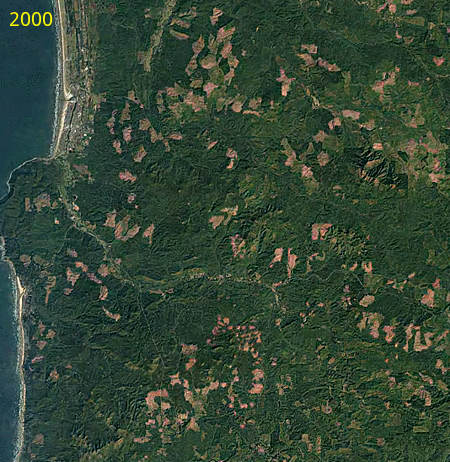Oregon’s coastal communities that rely on drinking water from forested rivers and creeks have lost substantial tree cover during the last 20 years, a recent NASA analysis found.
That’s bad news for residents and the environment, the report indicates.
Forests not only improve the quality of surface waters, but also the quantity. They prevent erosion, and filter, direct and store rain and snow as they pass into streams, according to the researchers. And more than 80% of Oregonians, including most who live on the coasts, get some or all of their drinking water from surface water sources such as streams, rivers and creeks, according to the Oregon Department of Environmental Quality.

“We think of the coast range as having a lot of water, a lot of rain – and while that’s true in the winter – lately their streams are running pretty low during the summer months,” said Erik Fernandez, a program manager at the environmental nonprofit Oregon Wild who worked with NASA researchers on the analysis.
Young trees planted to replace logged mature trees also end up sucking up more water, further depleting surface water supply, Fernandez said. He also expressed concern that planting new tree stands requires spraying herbicides and pesticides, sometimes aerially, that can harm water sources.
Seth Barnes, forest policy director for the Oregon Forest Industries Council, said the more than 50-year-old Oregon Forest Practices Act, currently being updated, strongly protects water in Oregon’s logged forests.
“There’s really literally hundreds of protections that are put in place when anything is harvested in the state of Oregon,” Barnes said. “Things like stream buffers, harvest practices that are very specific and nuanced, reforestation requirements, steep slopes protections.”
Using data and satellite imagery from NASA collected between 1997 and 2023, four researchers from the agency’s Oregon Coast Range Ecological Conservation Team were able to look at logging impacts in forests within 80 Oregon Coast watersheds identified by Oregon Wild.
About one-third of the forested land in those 80 watersheds — nearly 600 square miles — had been logged during the last 20 years, according to the study.
“Over the last 20 years it would be entirely inaccurate to say logging in the Coast Range was done carefully. I don’t think you can look at an aerial photo and say it was done carefully,” Fernandez said.
The bulk of logging in watershed forests during this time was on land owned by industrial logging companies, followed by state and federal agencies, tribes and local municipalities. Those companies, including Weyerhaeuser, Stimson Lumber and Roseburg Forest Products, use a method called clearcutting, defined by the NASA researchers as the removal of all trees in an area exceeding 2 acres. Representatives from those companies did not respond to requests for comment from the Capital Chronicle by Monday evening.
Barnes said the companies and members of the Forest Industries Council have high compliance rates with the Forest Practices Act, including complying with regulations on water quality.
“We live in these watersheds and our families drink this water and recreate in these forests too,” and we want to be good stewards,” he said.
Casey Kulla, state forest policy coordinator for Oregon Wild, said he hopes the NASA analysis can aid efforts by some Oregon cities to buy and manage the forestland around their drinking watersheds.
The state recently passed legislation to create a Community Drinking Water Enhancement and Protection Fund with $5 million available for communities hoping to own or improve land around their source drinking water.
The Oregon Capital Chronicle is a professional, nonprofit news organization. We are an affiliate of States Newsroom, a national 501(c)(3) nonprofit supported by grants and a coalition of donors and readers. The Capital Chronicle retains full editorial independence, meaning decisions about news and coverage are made by Oregonians for Oregonians.


